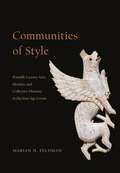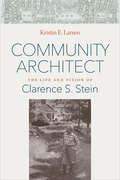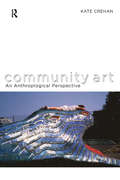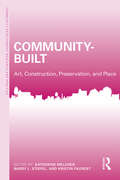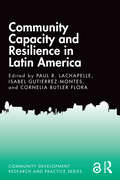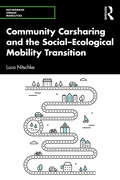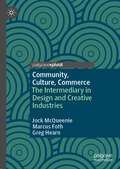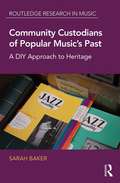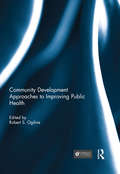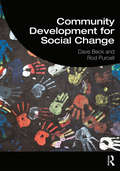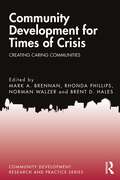- Table View
- List View
Communities of Style: Portable Luxury Arts, Identity, and Collective Memory in the Iron Age Levant
by Marian H. FeldmanCommunities of Style examines the production and circulation of portable luxury goods throughout the Levant in the early Iron Age (1200–600 BCE). In particular it focuses on how societies in flux came together around the material effects of art and style, and their role in collective memory. Marian H. Feldman brings her dual training as an art historian and an archaeologist to bear on the networks that were essential to the movement and trade of luxury goods—particularly ivories and metal works—and how they were also central to community formation. The interest in, and relationships to, these art objects, Feldman shows, led to wide-ranging interactions and transformations both within and between communities. Ultimately, she argues, the production and movement of luxury goods in the period demands a rethinking of our very geo-cultural conception of the Levant, as well as its influence beyond what have traditionally been thought of as its borders.
Communities of Style: Portable Luxury Arts, Identity, and Collective Memory in the Iron Age Levant
by Marian H. FeldmanCommunities of Style examines the production and circulation of portable luxury goods throughout the Levant in the early Iron Age (1200–600 BCE). In particular it focuses on how societies in flux came together around the material effects of art and style, and their role in collective memory. Marian H. Feldman brings her dual training as an art historian and an archaeologist to bear on the networks that were essential to the movement and trade of luxury goods—particularly ivories and metal works—and how they were also central to community formation. The interest in, and relationships to, these art objects, Feldman shows, led to wide-ranging interactions and transformations both within and between communities. Ultimately, she argues, the production and movement of luxury goods in the period demands a rethinking of our very geo-cultural conception of the Levant, as well as its influence beyond what have traditionally been thought of as its borders.
Communities of Style: Portable Luxury Arts, Identity, and Collective Memory in the Iron Age Levant
by Marian H. FeldmanCommunities of Style examines the production and circulation of portable luxury goods throughout the Levant in the early Iron Age (1200–600 BCE). In particular it focuses on how societies in flux came together around the material effects of art and style, and their role in collective memory. Marian H. Feldman brings her dual training as an art historian and an archaeologist to bear on the networks that were essential to the movement and trade of luxury goods—particularly ivories and metal works—and how they were also central to community formation. The interest in, and relationships to, these art objects, Feldman shows, led to wide-ranging interactions and transformations both within and between communities. Ultimately, she argues, the production and movement of luxury goods in the period demands a rethinking of our very geo-cultural conception of the Levant, as well as its influence beyond what have traditionally been thought of as its borders.
Communities of Style: Portable Luxury Arts, Identity, and Collective Memory in the Iron Age Levant
by Marian H. FeldmanCommunities of Style examines the production and circulation of portable luxury goods throughout the Levant in the early Iron Age (1200–600 BCE). In particular it focuses on how societies in flux came together around the material effects of art and style, and their role in collective memory. Marian H. Feldman brings her dual training as an art historian and an archaeologist to bear on the networks that were essential to the movement and trade of luxury goods—particularly ivories and metal works—and how they were also central to community formation. The interest in, and relationships to, these art objects, Feldman shows, led to wide-ranging interactions and transformations both within and between communities. Ultimately, she argues, the production and movement of luxury goods in the period demands a rethinking of our very geo-cultural conception of the Levant, as well as its influence beyond what have traditionally been thought of as its borders.
Communities, Performance and Practice: Enacting Communities
by Kerrie SchaeferThis book examines how a predominantly negative view of community has presented a challenge to critical analysis of community performance practice. The concept of community as a form of class-based solidarity has been hollowed out by postmodernism’s questioning of grand narratives and poststructuralism’s celebration of difference. Alongside the critique of a notion of community has been a critical re-signification of community, following the thinking of philosopher Jean-Luc Nancy who conceives of community not as common being but as being-in-common. The concept of community as being-in-common generates questions that have been taken up by feminist geographers, J.K. Gibson-Graham, in theorising a post-capitalist approach to community-based development. These questions and approaches guide the analyses in researched case studies of community performance practice. The book revises theoretical debates that have defined the field of community theatre and performance. It asks how the critical re-signification of community aligns with these debates and, at the same time, opens new modes of critical analysis of community theatre and performance practice.
Community Architect: The Life and Vision of Clarence S. Stein
by Kristin E. LarsenClarence S. Stein (1882–1975) was an architect, housing visionary, regionalist, policymaker, and colleague of some of the most influential public figures of the early to mid-twentieth century, including Lewis Mumford and Benton MacKaye. Kristin E. Larsen’s biography of Stein comprehensively examines his built and unbuilt projects and his intellectual legacy as a proponent of the "garden city" for a modern age. This examination of Stein’s life and legacy focuses on four critical themes: his collaborative ethic in envisioning policy, design, and development solutions; promotion and implementation of "investment housing;" his revolutionary approach to community design, as epitomized in the Radburn Idea; and his advocacy of communitarian regionalism. His cutting-edge projects such as Sunnyside Gardens in New York City; Baldwin Hills Village in Los Angeles; and Radburn, New Jersey, his "town for the motor age," continue to inspire community designers and planners in the United States and around the world.Stein was among the first architects to integrate new design solutions and support facilities into large-scale projects intended primarily to house working-class people, and he was a cofounder of the Regional Planning Association of America. As a planner, designer, and, at times, financier of new housing developments, Stein wrestled with the challenges of creating what today we would term "livable," "walkable," and "green" communities during the ascendency of the automobile. He managed these challenges by partnering private capital with government funding, as well as by collaborating with colleagues in planning, architecture, real estate, and politics.
Community Art: An Anthropological Perspective
by Kate CrehanExploring key issues for the anthropology of art and art theory, this fascinating text provides the first in-depth study of community art from an anthropological perspective.The book focuses on the forty year history of Free Form Arts Trust, an arts group that played a major part in the 1970s struggle to carve out a space for community arts in Britain. Turning their back on the world of gallery art, the fine-artist founders of Free Form were determined to use their visual expertise to connect, through collaborative art projects, with the working-class people excluded by the established art world. In seeking to give the residents of poor communities a greater role in shaping their built environment, the artists' aesthetic practice would be transformed.Community Art examines this process of aesthetic transformation and its rejection of the individualized practice of the gallery artist. The Free Form story calls into question common understandings of the categories of "art," "expertise," and "community," and makes this story relevant beyond late twentieth-century and early twenty-first-century Britain.
Community Art: An Anthropological Perspective
by Kate CrehanExploring key issues for the anthropology of art and art theory, this fascinating text provides the first in-depth study of community art from an anthropological perspective.The book focuses on the forty year history of Free Form Arts Trust, an arts group that played a major part in the 1970s struggle to carve out a space for community arts in Britain. Turning their back on the world of gallery art, the fine-artist founders of Free Form were determined to use their visual expertise to connect, through collaborative art projects, with the working-class people excluded by the established art world. In seeking to give the residents of poor communities a greater role in shaping their built environment, the artists' aesthetic practice would be transformed.Community Art examines this process of aesthetic transformation and its rejection of the individualized practice of the gallery artist. The Free Form story calls into question common understandings of the categories of "art," "expertise," and "community," and makes this story relevant beyond late twentieth-century and early twenty-first-century Britain.
Community-Based Urban Development: Evolving Urban Paradigms in Singapore and Seoul (Advances in 21st Century Human Settlements)
by Im Sik Cho Blaž KrižnikThe book compares different approaches to urban development in Singapore and Seoul over the past decades, by focusing on community participation in the transformation of neighbourhoods and its impact on the built environment and communal life. Singapore and Seoul are known for their rapid economic growth and urbanisation under a strong control of developmental state in the past. However, these cities are at a critical crossroads of societal transformation, where participatory and community-based urban development is gaining importance. This new approach can be seen as a result of a changing relationship between the state and civil society, where an emerging partnership between both aims to overcome the limitations of earlier urban development. The book draws attention to the possibilities and challenges that these cities face while moving towards a more inclusive and socially sustainable post-developmental urbanisation. By applying a comparative perspective to understand the evolving urban paradigms in Singapore and Seoul, this unique and timely book offers insights for scholars, professionals and students interested in contemporary Asian urbanisation and its future trajectories.
Community-Built: Art, Construction, Preservation, and Place (Community Development Research and Practice Series)
by Katherine Melcher Barry Stiefel Kristin FaurestThroughout history and around the world, community members have come together to build places, be it settlers constructing log cabins in nineteenth-century Canada, an artist group creating a waterfront gathering place along the Danube in Budapest, or residents helping revive small-town main streets in the United States. What all these projects have in common is that they involve local volunteers in the construction of public and community places; they are community-built. Although much attention has been given to specific community-built movements such as public murals and community gardens, little has been given to defining community-built as a whole. This volume provides a preliminary description of community-built practices with examples from the disciplines of urban design, historic preservation, and community art. Taken as a whole, these community-built projects illustrate how the process of local involvement in adapting, building, and preserving a built environment can strengthen communities and create places that are intimately tied to local needs, culture, and community. The lessons learned from this volume can provide community planners, grassroots facilitators, and participants with an understanding of what can lead to successful community-built art, construction, preservation, and placemaking.
Community-Built: Art, Construction, Preservation, and Place (Community Development Research and Practice Series)
by Katherine Melcher Barry Stiefel Kristin FaurestThroughout history and around the world, community members have come together to build places, be it settlers constructing log cabins in nineteenth-century Canada, an artist group creating a waterfront gathering place along the Danube in Budapest, or residents helping revive small-town main streets in the United States. What all these projects have in common is that they involve local volunteers in the construction of public and community places; they are community-built. Although much attention has been given to specific community-built movements such as public murals and community gardens, little has been given to defining community-built as a whole. This volume provides a preliminary description of community-built practices with examples from the disciplines of urban design, historic preservation, and community art. Taken as a whole, these community-built projects illustrate how the process of local involvement in adapting, building, and preserving a built environment can strengthen communities and create places that are intimately tied to local needs, culture, and community. The lessons learned from this volume can provide community planners, grassroots facilitators, and participants with an understanding of what can lead to successful community-built art, construction, preservation, and placemaking.
Community Capacity and Resilience in Latin America (Community Development Research and Practice Series)
by Paul R. Lachapelle Isabel Gutierrez-Montes Cornelia Butler FloraCommunity Capacity and Resilience in Latin America addresses the role of communities in building their capacity to increase resiliency and carry out rural development strategies in Latin America. Resiliency in a community sense is associated with an ability to address stress and respond to shock while obtaining participatory engagement in community assessment, planning and outcome. Although the political contexts for community development have changed dramatically in a number of Latin American countries in recent years, there are growing opportunities and examples of communities working together to address common problems and improve collective quality of life. This book links scholarship that highlights community development praxis using new frameworks to understand the potential for community capacity and resiliency. By rejecting old linear models of development, based on technology transfer and diffusion of technology, many communities in Latin America have built capacity of their capital assets to become more resilient and adapt positively to change. This book is an essential resource for academics and practitioners of rural development, demonstrating that there is much we can learn from the skills of self-diagnosis and building on existing assets to enhance community capitals. Chapter 3 of this book is freely available as a downloadable Open Access PDF at http://www.taylorfrancis.com under a Creative Commons Attribution (CC-BY) 4.0 license.
Community Capacity and Resilience in Latin America (Community Development Research and Practice Series)
by Paul R. Lachapelle Isabel Gutierrez-Montes Cornelia Butler FloraCommunity Capacity and Resilience in Latin America addresses the role of communities in building their capacity to increase resiliency and carry out rural development strategies in Latin America. Resiliency in a community sense is associated with an ability to address stress and respond to shock while obtaining participatory engagement in community assessment, planning and outcome. Although the political contexts for community development have changed dramatically in a number of Latin American countries in recent years, there are growing opportunities and examples of communities working together to address common problems and improve collective quality of life. This book links scholarship that highlights community development praxis using new frameworks to understand the potential for community capacity and resiliency. By rejecting old linear models of development, based on technology transfer and diffusion of technology, many communities in Latin America have built capacity of their capital assets to become more resilient and adapt positively to change. This book is an essential resource for academics and practitioners of rural development, demonstrating that there is much we can learn from the skills of self-diagnosis and building on existing assets to enhance community capitals. Chapter 3 of this book is freely available as a downloadable Open Access PDF at http://www.taylorfrancis.com under a Creative Commons Attribution (CC-BY) 4.0 license.
Community Carsharing and the Social–Ecological Mobility Transition (Networked Urban Mobilities Series)
by Luca NitschkeThis book investigates how practices of community carsharing are influencing everyday mobility. It argues that hegemonic practices of automobility are reconfigured through practices of community carsharing, thereby challenging capitalist mobilities in the realm of everyday life. Through a detailed empirical study of practices of community carsharing and its practitioners in the rural regions around Munich, Germany, this book reveals how the practice contributes to the emergence of alternative automobile practices, meanings, identities and subjectivities. It also explores the embedding of automobility into its ecological context, the connection of function and community in practices of community carsharing and the changing of ownership relations through a process of commoning mobility. This reconfiguration of everyday practices of automobility takes place through processes of everyday resistance, re-embedding and commoning, and ultimately results in the emergence of an alternative mobility culture, thereby facilitating the dissemination of an alternative common sense of community carsharing. This book on community carsharing provides a valuable insight into carsharing in rural settings and exemplifies how carsharing specifically, and sharing mobilities in general, can contribute to a social–ecological mobility transition. The work will be of particular interest to scholars and practitioners working in mobility studies and mobilities.
Community Carsharing and the Social–Ecological Mobility Transition (Networked Urban Mobilities Series)
by Luca NitschkeThis book investigates how practices of community carsharing are influencing everyday mobility. It argues that hegemonic practices of automobility are reconfigured through practices of community carsharing, thereby challenging capitalist mobilities in the realm of everyday life. Through a detailed empirical study of practices of community carsharing and its practitioners in the rural regions around Munich, Germany, this book reveals how the practice contributes to the emergence of alternative automobile practices, meanings, identities and subjectivities. It also explores the embedding of automobility into its ecological context, the connection of function and community in practices of community carsharing and the changing of ownership relations through a process of commoning mobility. This reconfiguration of everyday practices of automobility takes place through processes of everyday resistance, re-embedding and commoning, and ultimately results in the emergence of an alternative mobility culture, thereby facilitating the dissemination of an alternative common sense of community carsharing. This book on community carsharing provides a valuable insight into carsharing in rural settings and exemplifies how carsharing specifically, and sharing mobilities in general, can contribute to a social–ecological mobility transition. The work will be of particular interest to scholars and practitioners working in mobility studies and mobilities.
Community, Culture, Commerce: The Intermediary in Design and Creative Industries
by Jock McQueenie Marcus Foth Greg HearnAs digital environments become increasingly individualised, instant, ubiquitous, and disintermediated, this book demonstrates the continuing relevance of intermediaries at the intersection of design, creativity, community engagement, and corporate social responsibility. The authors examine intermediaries as enablers of mutual benefit and offer a proactive, interventionist, and holistic approach to intermediation practice that steps beyond design thinking. By means of case studies that employ the 3C project design methodology—Community, Culture, Commerce—the authors provide an accessible introduction to intermediation at the nexus of theory and practice and signpost new opportunities for researchers and practitioners in the post-COVID environment.
Community Custodians of Popular Music's Past: A DIY Approach to Heritage (Routledge Research in Music)
by Sarah BakerThis book examines do-it-yourself (DIY) approaches to the collection, preservation, and display of popular music heritage being undertaken by volunteers in community archives, museums and halls of fame globally. DIY institutions of popular music heritage are much more than ‘unofficial’ versions of ‘official’ institutions; rather, they invoke a complex network of affect and sociality, and are sites where interested people – often enthusiasts – are able to assemble around shared goals related to the preservation of and ownership over the material histories of popular music culture. Drawing on interviews and observations with founders, volunteers and heritage workers in 23 DIY institutions in Australasia, Europe and North America, the book highlights the potentialities of bottom-up, community-based interventions into the archiving and preservation of popular music’s material history. It reveals the kinds of collections being housed in these archives, how they are managed and maintained, and explores their relationship to mainstream heritage institutions. The study also considers the cultural labor of volunteers in the DIY institution, arguing that while these are places concerned with heritage management and the preservation of artefacts, they are also extensions of musical communities in the present in which activities around popular music preservation have personal, cultural, community and heritage benefits. By looking at volunteers’ everyday interventions in the archiving and curating of popular music’s material past, the book highlights how DIY institutions build upon national heritage strategies at the community level and have the capacity to contribute to the democratization of popular music heritage. This book will have a broad appeal to a range of scholars in the fields of popular music studies, musicology, ethnomusicology, archive studies and archival science, museum studies, critical heritage studies, cultural studies, cultural sociology and media studies.
Community Custodians of Popular Music's Past: A DIY Approach to Heritage (Routledge Research in Music)
by Sarah BakerThis book examines do-it-yourself (DIY) approaches to the collection, preservation, and display of popular music heritage being undertaken by volunteers in community archives, museums and halls of fame globally. DIY institutions of popular music heritage are much more than ‘unofficial’ versions of ‘official’ institutions; rather, they invoke a complex network of affect and sociality, and are sites where interested people – often enthusiasts – are able to assemble around shared goals related to the preservation of and ownership over the material histories of popular music culture. Drawing on interviews and observations with founders, volunteers and heritage workers in 23 DIY institutions in Australasia, Europe and North America, the book highlights the potentialities of bottom-up, community-based interventions into the archiving and preservation of popular music’s material history. It reveals the kinds of collections being housed in these archives, how they are managed and maintained, and explores their relationship to mainstream heritage institutions. The study also considers the cultural labor of volunteers in the DIY institution, arguing that while these are places concerned with heritage management and the preservation of artefacts, they are also extensions of musical communities in the present in which activities around popular music preservation have personal, cultural, community and heritage benefits. By looking at volunteers’ everyday interventions in the archiving and curating of popular music’s material past, the book highlights how DIY institutions build upon national heritage strategies at the community level and have the capacity to contribute to the democratization of popular music heritage. This book will have a broad appeal to a range of scholars in the fields of popular music studies, musicology, ethnomusicology, archive studies and archival science, museum studies, critical heritage studies, cultural studies, cultural sociology and media studies.
Community Development and Schools: Conflict, Power and Promise (ISSN)
by Mildred E. Warner Xue Zhang Jason ReeceThis book lays out the promise and potential of schools as community-building institutions. It explores the challenges faced in incorporating schools into broader community development policy, and also recognizes the changing demographics of schools and their need to integrate with economic development policy in order to promote broader community development.The book includes chapters on tax abatements and economic development policy impacts on schools, new approaches to school building renovation, the potential and reach of shared services between communities and schools, and the impact of school-based health centers. It also offers a theory to integrate schools into community development. Key elements include shared power between communities and schools, greater transparency in economic development policy, collaboration across the broad range of community actors, and engagement of diverse voices. These elements build a greater sense of belonging across generations and class and racial divides.Creative democracy can broaden both school and community development agendas and build a culture of health. This book will help community development and school leaders recognize and pursue the promise of schools as critical community development actors.The Open Access version of this book, available at http://www.taylorfrancis.com, has been made available under a Creative Commons Attribution-Non Commercial (CC-BY-NC) 4.0 license.
Community Development and Schools: Conflict, Power and Promise (ISSN)
by Mildred E. Warner Xue Zhang Jason ReeceThis book lays out the promise and potential of schools as community-building institutions. It explores the challenges faced in incorporating schools into broader community development policy, and also recognizes the changing demographics of schools and their need to integrate with economic development policy in order to promote broader community development.The book includes chapters on tax abatements and economic development policy impacts on schools, new approaches to school building renovation, the potential and reach of shared services between communities and schools, and the impact of school-based health centers. It also offers a theory to integrate schools into community development. Key elements include shared power between communities and schools, greater transparency in economic development policy, collaboration across the broad range of community actors, and engagement of diverse voices. These elements build a greater sense of belonging across generations and class and racial divides.Creative democracy can broaden both school and community development agendas and build a culture of health. This book will help community development and school leaders recognize and pursue the promise of schools as critical community development actors.The Open Access version of this book, available at http://www.taylorfrancis.com, has been made available under a Creative Commons Attribution-Non Commercial (CC-BY-NC) 4.0 license.
Community Development Approaches to Improving Public Health (Community Development – Current Issues Series)
by Robert S. OgilvieAs the rates of chronic diseases, like diabetes, asthma and obesity skyrocket, research is showing that the built environment – the way our cities and towns are developed – contributes to the epidemic rates of these diseases. It is unlikely that those who planned and developed these places envisioned these situations. Public health, community development planning, and other fields influencing the built environment have operated in isolation for much of recent history, with the result being places that public health advocates have labelled, ‘designed for disease’. The sad irony of this is that planning and public health arose together, in response to the need to create health standards, zoning and building codes to combat the infectious diseases that were prevalent in the industrializing cities of late nineteenth and early twentieth century America. In recent years, the dramatic rise in chronic disease rates in cities and towns has begun to bring public health and planning back together to promote development pattern and policies facilitating physical activity and neighbourly interactions as antidotes. In this book, a number of such community development efforts are highlighted, bringing attention to the need to coordinate planning, community development and health policy. This book was originally published as a special issue of Community Development.
Community Development Approaches to Improving Public Health (Community Development – Current Issues Series)
by Robert S. OgilvieAs the rates of chronic diseases, like diabetes, asthma and obesity skyrocket, research is showing that the built environment – the way our cities and towns are developed – contributes to the epidemic rates of these diseases. It is unlikely that those who planned and developed these places envisioned these situations. Public health, community development planning, and other fields influencing the built environment have operated in isolation for much of recent history, with the result being places that public health advocates have labelled, ‘designed for disease’. The sad irony of this is that planning and public health arose together, in response to the need to create health standards, zoning and building codes to combat the infectious diseases that were prevalent in the industrializing cities of late nineteenth and early twentieth century America. In recent years, the dramatic rise in chronic disease rates in cities and towns has begun to bring public health and planning back together to promote development pattern and policies facilitating physical activity and neighbourly interactions as antidotes. In this book, a number of such community development efforts are highlighted, bringing attention to the need to coordinate planning, community development and health policy. This book was originally published as a special issue of Community Development.
Community Development for Social Change
by Dave Beck Rod PurcellCommunity Development for Social Change provides a comprehensive introduction to the theory and practice of community development and associated activities, discusses best practice from global experience and links that to the UK context. The book integrates the realities of practice to key underpinning theories, human rights, values and a commitment to promoting social justice. A range of practice models are described and analysed, including UK models, popular education and community organising, as well as a range of practice issues that need to be understood by community development workers. For example, strategies to promote individual and community empowerment, challenging discrimination, building and sustaining groups, and critical reflection on practice. Finally, a range of case studies from the UK and overseas illustrates good practice in diverse contexts. These case studies are analysed with reference to the values of community development, the promotion of social justice and the underpinning theories. It is an essential text for those on community development courses as well as for a range of workers, including local government, national and local voluntary agencies, and community-based organisations.
Community Development for Social Change
by Dave Beck Rod PurcellCommunity Development for Social Change provides a comprehensive introduction to the theory and practice of community development and associated activities, discusses best practice from global experience and links that to the UK context. The book integrates the realities of practice to key underpinning theories, human rights, values and a commitment to promoting social justice. A range of practice models are described and analysed, including UK models, popular education and community organising, as well as a range of practice issues that need to be understood by community development workers. For example, strategies to promote individual and community empowerment, challenging discrimination, building and sustaining groups, and critical reflection on practice. Finally, a range of case studies from the UK and overseas illustrates good practice in diverse contexts. These case studies are analysed with reference to the values of community development, the promotion of social justice and the underpinning theories. It is an essential text for those on community development courses as well as for a range of workers, including local government, national and local voluntary agencies, and community-based organisations.
Community Development for Times of Crisis: Creating Caring Communities (Community Development Research and Practice Series)
by Mark A. BrennanThis book explores the intersection of community development and local capacity building as a basis for effective disaster mitigation and the alleviation of suffering in times of crisis. Beginning with the Community Development section, the process, context, and methods for community, engagement, and development can be viewed from different structural and logical approaches. This section explores some of the more relevant historical arguments, as well as more contemporary examinations. The second section looks at Critical Human and Community Considerations and sheds light on some of the key concepts that are often overlooked (poverty, race, inequality, social justice, mental health, social division) when framing community responses to disaster. The third section focuses on Fundamental Elements of Caring Communities. This section explores the importance, practical, and measurable impacts of social support, empathy, inclusion, and conflict resolution in creating effective and caring community responses. Finally, the last section focuses on practice and brings together research and theory into applied programming, examples, and evidence from on-the-ground efforts to establish caring communities that respond to local needs in times of crisis and beyond. By addressing these objectives, this book provides a more complete understanding of the essential role that community can play in disaster mitigation. Doing this will provide a better focus for ongoing research endeavors, and program and policy initiatives at the community level that seek to prepare for, respond to, and recover from natural and other disasters. As a result, this book contributes to wider and more sustainable development of our communities beyond disasters, while furthering dialog among community scholars and practitioners.
